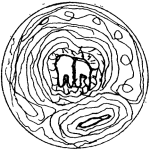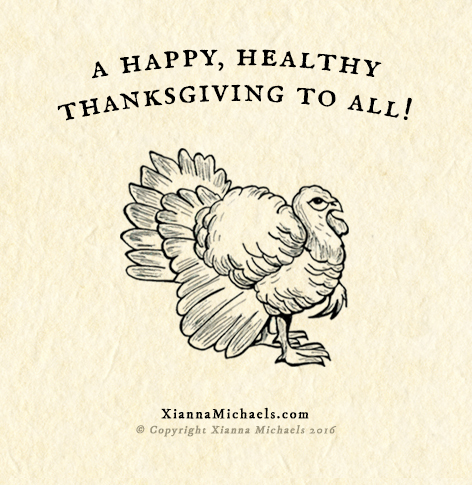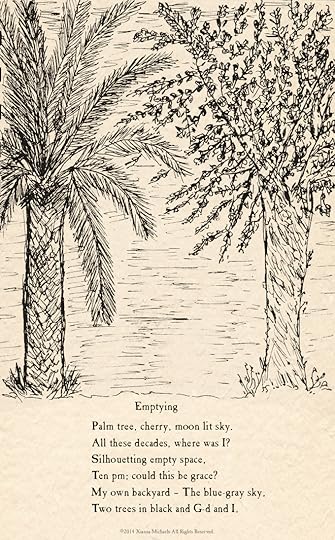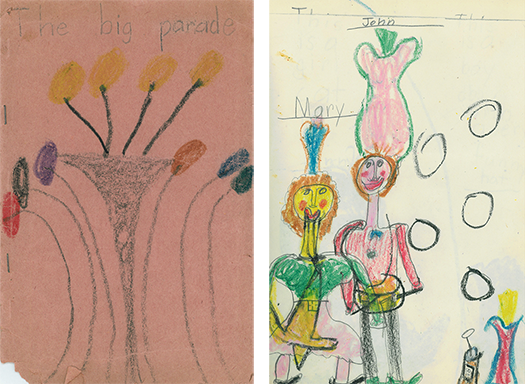Xianna Michaels's Blog, page 5
February 5, 2017
What I’ve Been Up to Lately
Dear Reader,
Many of you have been asking what I’ve been up to lately and I’m thrilled that as 2017 gets underway, I do have exciting news to share! I’ve just sent my newest book off to the printer! It’s called The Alchemy of Illuminated Poetry®—Seven Steps to Your Personal Gold and will be published in June 2017.
I created The Alchemy of Illuminated Poetry® process as part of my own inner work and had been doing it as a daily practice for years, without realizing that others might want to learn it and do it as well. It was my dear friend and calligraphy teacher, DeAnn Singh, who encouraged me to teach it and write a book about it. Now I can’t wait to share this with everyone! It’s a mystical, magical process for self-transformation and healing. It’s nothing like your English teacher’s poetry—which I can promise even if I happened to have been your English teacher way back when! Alchemy is all about transformation, and this book walks you through this process for whatever insights, personal growth and change you seek. You will draw in ways you never imagined, write words you didn’t know you were thinking, elicit answers to dilemmas you have not found before, and if you wish, connect with your inner, Higher Self.
Right now, for just a preview of what this is all about, here’s a drawing I did with my left (non-dominant) hand one day when I was trying to understand the origin of a toothache for which the dentist could find no organic cause. My left hand started drawing teeth in the center of the circle, or mandala, but the teeth turned into eyes. Hmmm… what could my intuitive brain be trying to tell me?
In the coming months I’ll be sharing some of the poems and drawings I’ve done using this process. Stay tuned…
Very best wishes,
Xianna Michaels
The post What I’ve Been Up to Lately appeared first on Xianna Michaels.
December 29, 2016
Happy Chanukah!
Here’s a Chanukah poem I wrote when I was 9 years old. Happy Chanukah to everyone!
The post Happy Chanukah! appeared first on Xianna Michaels.
November 23, 2016
Happy Thanksgiving!
October 26, 2016
Teachers’ Words Matter
In September of this year I began a series of stories to express my gratitude to a few people whom I knew only briefly but who had a tremendous impact on my work and my life. Though I thanked them at the time, it’s only in retrospect that I know just how momentous their words turned out to be for me. And so I’d like to express my gratitude now on a much deeper level.
My first story was about a career counselor I met with in the late ’70s. For this one, I’d like to take you to the early 2000s. I was in the middle of writing one of my verse fairy tales. I write with my right hand, but for years my left hand had been intuitively drawing medieval scenes. I had started with doodles of grass and trees, and somehow my doodles had evolved into cows in pastures, knights on horseback and slightly crooked castles. People had begun to ask me if I was going to illustrate my books, but I knew I had a long way to go.
So in an attempt to gain some artistic expertise, I took a pen and ink drawing class at what was then Learning Tree University in the San Fernando Valley, which offered adult education in the arts, among other interesting courses. My first instructor, a very talented self-taught pen and ink artist, insisted we use a ruler to create precision work. I was not very good at this, needless to say, and somehow using a ruler to craft perfectly straight lines seemed to take the joy out of drawing for me. I left that class feeling that my work could never measure up to professional standards. So I kept on doing my intuitive drawings, and then found another class at the same school.
I wish I remembered the name of the teacher, but alas, I do not. This was a class in Celtic Art, the art of early medieval Britain and Ireland. I knew that Celtic Art is very geometric (translation: it involves rulers), but the course description included work in decorative letters such as are found in medieval manuscripts, and this, I thought, was right up my alley.
My Celtic art project
The teacher had us do one major project of a lavishly illustrated set of initials. It was to be done in full color in whatever medium we chose. Most students decided to work with watercolors or pastels. As my preferred medium is pen and black ink, I decided to work with colored ink for the project. As per the assignment, I created intertwining geometric initials embellished with swirls and abstract elements within the principles of Celtic design and balance. The colors were vibrant and I thought the overall effect rather pleasing, though I certainly didn’t think that it qualified as art. Certainly it had nothing to do with the drawings that kept coming from my pen.
But the teacher and I got to talking about my verse fairy tales and the somewhat amateurish, sketchy and wholly unexpected illustrations that were emerging from my left hand. In one of our last sessions she asked to see some of my work. With trepidation I showed her my untutored doodles. What she said in response truly surprised me. I repeat her words not, I assure you, dear Reader, to pat myself on the back, but because words matter and hers very possibly changed the course of my life.
“You have your own unique style. Yes, you need practice and discipline, but you don’t necessarily need instruction. Your work is whimsical and has a certain pleasing delight to it. Just keep doing what you’re doing. Don’t let anyone talk you out of it. One day your work will be of publishable quality.”
I was absolutely stunned. I never expected her—or anyone—to say such a thing to me. I considered myself a writer and poet, not an artist. How could my left-handed doodles have any value?
One of my early left-handed doodles turning into a medieval scene
The creative soul at whatever age can be very fragile (and I was already a grandmother!) It is very easy to dismiss what we produce as having little or no worth. Her kind words gave me confidence, made me think for the very first time that there was a reason my left hand, almost of it’s own volition, was drawing increasingly recognizable medieval scenes. In that brief conversation she also gave me courage, patience and faith in my own process. So I kept drawing, giving my left hand free reign, and eventually letting my right hand take over when I needed precision work, such as for piles of castle stone or tiny dragon scales. I’ve often said that my left hand taught my right hand how to draw. But that very possibly never would have happened had this teacher not given me the encouragement, in a certain way the permission, to keep going.
It would be almost seven years later in 2010 that I would meet my calligraphy teacher, DeAnn Singh of Designing Letters in Los Angeles. I have been studying with her ever since and she has taught me not only calligraphy but vital elements of pen and ink illustration that I could not acquire on my own. I am forever grateful to DeAnn and treasure my time with her. But I think it is safe to say that I might never have felt myself ready to begin studying with her, certainly would not have had the confidence in my own progress to initiate contact with her, had it not been for the words of that long-ago Celtic Art teacher.
And it would be more than eleven years after I took her class that I published my first illustrated medieval verse fairytale, Mindel and the Misfit Dragons. Yet I know that she was a vital link in the chain that brought my work to fruition.
I did thank her at the time, but as with the career counselor I wrote about previously, I did not realize then how significant her words would be for my life. I no longer know her name, nor where she is, but I would like her to know now that she has my eternal gratitude. Words matter, and hers made all the difference.
Check out my first gratitude post, “Nine Words that Made All the Difference” here.
The post Teachers’ Words Matter appeared first on Xianna Michaels.
September 27, 2016
L’shana Tova!
September 26, 2016
Color me Sukkos!
Looking for an activity for the little ones before Sukkos? Check out these downloadable coloring pages adapted from some of the posters I’ve created over the years for my children and grandchildren to color and hang in the sukkah. Check out the dragon in the sukkah! That was done at my grandkids’ request after the publication of Mindel and the Misfit Dragons. Feel free to use these or create your own!
Click here to download a printable PDF

The post Color me Sukkos! appeared first on Xianna Michaels.
Contemplation in the Days of Awe
A meaningful Yom Kippur to all. May all our prayers for the coming year be answered. In these High Holy Days of contemplation, I am thinking of a poem I wrote in a special moment of connection with G-d.
The post Contemplation in the Days of Awe appeared first on Xianna Michaels.
September 19, 2016
In Honor of World Gratitude Day: Nine Words That Made All the Difference
In honor of World Gratitude Day, which is September 21st this year, I would like to begin a new series of stories to express my gratitude to a few people whom I knew only briefly—or in one case never knew at all. They would each have a profound impact on my work and the course of my life, and though I thanked them at the time, I had no way of knowing just how momentous their words would turn out to be. And so I want to express my gratitude now, if I may, on a much deeper level.
I will begin with a career counselor I went to see back in the late 70’s at what was then called Cal State Northridge, now California State University at Northridge (CSUN.) I was not a student there, but the public was allowed to use their career services. I had been teaching for years, loving it, but knew that for a number of reasons I had to leave for awhile. Something else was calling me but I didn’t know what. I had several small children and knew that I wanted to work parttime, but I had no idea what to do.
I met with a lovely lady who gave me a battery of tests that told me everything about my skills and preferences that I already knew. There were no revelations. As I stood to leave, thanking her, she asked me one last question. I’ll never know what made her ask it, but nothing would ever be the same again:
“What are you not telling me?”
The words that came out of my mouth in response completely surprised me. I had never even articulated them before. “Well, I always thought that someday I would take a course in writing books for children.”
And then she said the words that would change my life: “Instead of someday, why don’t you do it now?”
And that was the beginning of my discovering myself as a writer. In those few words she had brought some vague dream for the future into the present. “Oh,” I said. “Oh. I hadn’t thought of that. Maybe I will.”
And I did. It was not an instant transition from mostly left-brained oriented academic to mostly right-brained intuitive poet and writer. It would take many years, and many other people would help along the way. It would be a process of re-discovering the creativity of my childhood as well as evolving and finding my voice. That process, I believe, is still on-going. But it started with one woman, and nine simple words: “Instead of someday, why don’t you do it now?”
So I’d like to thank her again now, whoever, wherever she is. With the hindsight of many years, I want her to know that she changed my life.
Look Inside! Cover and illustration from the first book I ever wrote, age 6
The post In Honor of World Gratitude Day: Nine Words That Made All the Difference appeared first on Xianna Michaels.
August 23, 2016
Immigrant in My Own Land: A Baby Boomer Crosses the Digital Divide
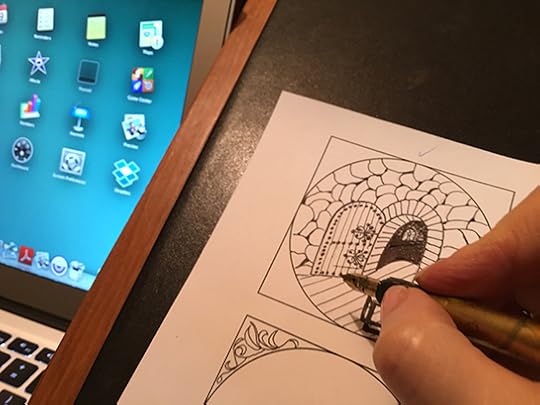
I am an immigrant. I was born in New York of American parents and have lived in California all of my adult life. So how on earth did I get to be an immigrant? I’ll tell you, but let me state at the outset that I am not alone in this predicament.
I am what is known as a digital immigrant, as opposed to my children, who are natives with some ties to the Old Country, and my grandchildren, who don’t remember the Old Country at all. Let me say also that I take no credit for coining this analogy, but I revel in how brilliant and spot-on it is. I do not, however, revel in my immigrant status. I was born here, after all. My grandparents were the immigrants, not speaking the language and more than slightly befuddled by their new surroundings. My parents were Depression babies, my father a World War II vet. I went to school here. I have a graduate degree, taught high school English for many years and thought I had a perfectly fine command of the language.
Except one day I realized I didn’t. There were whole portions of the language that I didn’t understand. Words like “gigabytes,” “scanning” (when not referring to analyzing the metrical pattern of a line of poetry), “resolution” (when not referring to coming to terms in a conflict), and “link” (when not referring to a bracelet); phrases like “the cloud,” “web surfing” and “social media” (how is it social when you don’t actually talk to people?). Not to mention the plethora of acronyms that seem to trip from the tongues of the digital natives. Things like PDF, URL and SEO. And don’t even get me started on the avalanche of proper nouns that were becoming household words, seemingly everywhere but in my household: Dropbox, Adobe, Safari (when not referring to wild animals), iEverything and Go-Daddy (where do they get these names?). I had not emigrated to a new country. But my country, the world I knew, was turning into a strange land. They call it the digital divide, and for a long time I was on the fossilized side, and quite content to be there, I might add.
I am a poet, writer, calligrapher, pen and ink artist. I sit at my slant board every day like a medieval scribe dipping my fountain pen into ink and happily scratching onto the page. I have long been aware that most writers love their word processors. But I came of age when typewriters meant jammed keys, carbon paper and little eraser wheels with brushes attached. My typing was so illegible that I received special dispensation in graduate school to hand-print my master’s thesis. My fountain pen by contrast has always felt like a natural extension of my hand. I love the feeling of the pen sweeping across the page and the idiosyncratic artistry of handwriting. The movement of my hand is part of my creative process; sometimes the pen knows before the mind what I will write. I discovered fountain pens when I was eight years old and never looked back.
Not all Baby Boomers were like me, of course. Some, like my husband, were early adopters. Way back in the 90’s, before the Internet was ubiquitous, he had a computer. I was never sure what mysterious rites he performed with it, but he seemed wholly enthralled. And as a physician, he had one of the first generation of cell phones. Oh yes, indeed, he did. It was the size of a shoe box and came cradled in its own carrying case. People came from far and near to gaze at this wireless wonder.
Eventually, I joined the modern age enough to own a cell phone. I appreciated the convenience, but had no interest in constantly upgrading to embrace the newest bells and whistles. A flip phone was just fine. And when my husband suggested buying me one of those new mini laptop computers for my birthday, I said I really couldn’t imagine what I would do with it, but I had my eye on a certain pair of earrings instead. The Internet had come into being, and every once in a while I would use my husband’s computer to look something up. But it certainly wasn’t essential to my life. I began to hear about people (my own children) shopping “online,” but I liked stores just fine.
Ironically, it was my brilliant calligraphy teacher and now dear friend, DeAnn Singh of Designing Letters in Los Angeles, who started me on the path of immigration into the digital world. I say “ironically” because DeAnn is a master of the ancient art of calligraphy. Her studio is full of every manner of antique dip fountain pens and ink. She has taught me not only calligraphy but so much of what I know of medieval manuscripts. She has 500 year old vellum specimens; walking into her studio is like stepping back in time. Or is it?
DeAnn, though a few years younger than I, is a sister Baby Boomer, and therefore another digital non-native. I remember early on in our time together how she extolled the virtues of the iPhone and iPad. I had not long before learned to text on my flip phone, much to the astonishment of my children, and I thought that was about as adventurous as I needed to be. I asked her, completely mystified, why she would want all these new-fangled devices. Her answer was one that I’ve never forgotten:
“I don’t want to be left behind.”
And then she showed me a series of absolutely gorgeous copies of medieval manuscript pages. On her iPad. She just pressed a few buttons and there they were! I was astonished. Then she held her phone in the palm of her hand and said, “This little device is a modern day miracle. Do you know what I can do with it, what I can find on it? The phone part of it is just the beginning.”
And that was my beginning. I got an iPhone and my grandchildren fought over who should set it up for me. I got an iPad for my work. Then I learned they could be synced (and I learned what “syncing” is). Then I learned how to buy music from iTunes. I play music as I work and now I could dispense with dozens of CDs and my temperamental CD player and just keep the phone nearby. I learned to create playlists, and, amazingly, I could get songs to repeat in an endless loop! I started taking tons of photos like everyone else in the known universe. I have my favorite translation of Psalms on my phone. And then there’s Dropbox.
A story goes with that. I had once asked my children what “the cloud” was, and though they gamely tried to explain, it was incomprehensible to me. So when DeAnn introduced me to my first art director, Emily Denis, I still thought the cloud was that fluffy white thing that produces rain in places other than Southern California. But as I worked with my fountain pen, hand-lettering and illustrating my verse fairytale, Mindel and the Misfit Dragons, Emily would take page after page and do something mysterious to “clean up” the copy digitally, and scan it into “the cloud.” And somehow, miraculously, before it was ever a hardcover book with pages I could turn, the entire manuscript could be pulled up on my phone in something called a Dropbox app. Mindel has long since become a published book, as has my multi-generational immigrant story, Lily of the Valley, but both live on my phone as well. Emily introduced me to many other marvels, and it’s fair to say that with remarkable forbearance, she pulled me into the 21st Century. She designed my websites, and patiently explained how I now had to produce “content.” My new art director, Marisa Raskin, has taught me how to type into Pages and send her PDFs that she can typeset, and Ruby A., my social media and marketing guru, has ever so gently initiated me into the labyrinth of the new media.
As you might have guessed, the entire team at my publishing company, Alcabal Press, LLC, is a generation younger than I. And I realize that like my children and grandchildren, their brains really are different from those of the immigrants. They are much more lateral in their thinking. They are fearless digitally. They are not afraid that if they press the wrong button, a year’s worth of work will disappear. But the technological revolution is forcing everyone to stay on their toes. I know this not only because my eldest granddaughter told me that she has more in common digitally with her parents than with her younger siblings. I also know it because I’ve been to the Apple Store lately.
It used to be that when I went there with a problem, they would tell me to make an appointment with one of their “geniuses.” I knew what that meant and so I started responding, “I don’t need a genius. I need someone who’s bilingual—that is, who speaks Baby Boomer English as well as tech-speak.” Years ago they used to give me pitying looks, but lately I get the feeling they’ve gotten the message, because I’m not the only one, apparently, who found the condescension of the so-called geniuses off-putting. Now I find very respectful, helpful people there. And there’s something else I discovered. It’s not just the Boomers struggling with the digital divide. In my last foray into Apple-land, I overheard three different conversations involving patrons in their 30’s and 40’s saying how confused they were, how everything was changing so fast, how they couldn’t keep up.
This did not give me the satisfaction of misery loves company, but rather supreme gratitude that my work and my family motivated me enough to venture into this new country. I will always be a foreigner, but I am very grateful to have younger generations to guide me. And when no one is available, I have discovered something else. You can Google “How to… almost anything” and there will be a YouTube video to instruct you. Imagine that! And yes, I know what YouTube is, and I use Google as a verb! As I learned back in the day when I was studying Linguistics, language is a living, changing entity.
And so I am changing, too. I still do all my artwork and poetry writing with a fountain pen. That will never change. Those processes for me are too intuitive for any other instrumentation. And yet… And yet… I now have three different devices. Yes, I do. And I use them! I have two websites…I sometimes shop online. … I do some of my research online. I email when necessary. And—dare I admit it?—I have learned to type my Journal entries, such as this very piece. I can actually compose prose with a keyboard! And I am writing my next book, a non-fiction book about The Alchemy of Illuminated Poetry® process which I’ve developed and which I teach, on a keyboard. Yes, dear reader, I am!
And I will admit to no small amount of satisfaction when I surprise a younger family member with some new-found skill. When I sent my very first text years ago, my oldest daughter responded with, “Wow, Mom! Welcome to the 21st Century!” My second daughter was probably my first tech teacher. When my books were still a glimmer in my eye, she suggested I secure domain names with Go-Daddy. I had no idea what she was talking about, but I handed over a credit card in blind faith. And eventually I did begin using those domain names. So imagine my delight when, just recently, I actually showed her what a certain icon meant, and got an “I’m impressed, Mom! You taught me something!” in response.
And then there are the grandchildren, whose skills advance at such a rapid rate as to leave all their elders spinning. But every once in a while, I surprise them. Not too long ago I got a call at 9:00 at night from my middle school granddaughter, who lives across the street.
“Nana, are you still dressed? Can you come over for a few minutes? Please? I have an essay due tomorrow. It’s only three paragraphs, and I only need you to check the grammar. I’ll have a printout for you. I know you like to correct on paper. It’ll be really quick!”
Now, I adore my grandkids and would do anything in my power for them. But I was tired and it was cold out. So I said, “How about if you email it to me, and I’ll print and hand-correct it, then scan it and email it back to you?”
Ah, dear reader, there was a most gratifying silence on the other end of the phone. And then a breathless, “Nana, you know how to do that?”
Oh yes, I do! And one day I’ll learn how to do the corrections right there on the computer on the original email, in a different color to highlight them. Maybe I’ll Google a YouTube video to teach me how.
The post Immigrant in My Own Land: A Baby Boomer Crosses the Digital Divide appeared first on Xianna Michaels.
July 26, 2016
What’s In a Name? More Than You Can Imagine
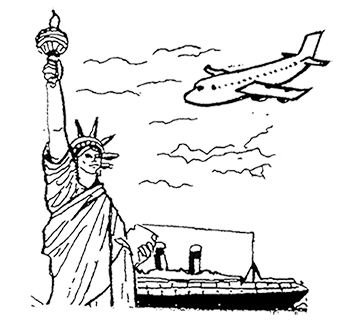
Shakespeare famously said, “What’s in a name? That which we call a rose/ By any other name would smell as sweet;” (Romeo and Juliet, Act II, Scene 2). But we know that names do in fact matter. I have always been fascinated by different naming customs, and the cycles of name popularity. My new book, Lily of the Valley—An American Jewish Journey, about five generations of American Jewish women, depicts a rather prototypical cycle of Ashkenazi (European) Jewish American naming customs.
The very first Lily leaves Eastern Europe with the name “Laili,” which an Ellis Island official declares unpronounceable. He re-names her “Lily” and she is thrilled to have what she considers an American name. It is the custom among Ashkenazi Jews to name after someone who has died, and so she names her daughter after her own mother, who was named “Malkie.” But that sounds too outdated, not American enough, so she calls her daughter “Molly.” Molly in turn will name her daughter “Lily,” after the first Lily, who has died, and so on through the generations.
In the society at large, we know that names go in cycles. The Mollys, Emmas, Lilys, Sams and Maxes of the early 20th Century became the baby boomer Marcias, Ellens, Lindas, Stewarts and Martins. The 80’s gave us Amanda, Megan, Lindsey and Sean. And now we seem to be back to Emma, Molly and Max.
But immigrants to our shores today often keep the names they were given in their home countries. Or try to. Which brings us to the hundreds of immigrants today known as FNU. There was a Wall Street Journal article by Miriam Jordan in March of 2016 about them. Apparently, these are people who came here from places like Afghanistan and parts of Asia and applied for visas with the only names they had—single, often very long first names. But U.S. immigration forms demand two names, and woe betide the hapless immigrant who leaves a blank. Many report that when they finally receive their visas, they are identified as FNU plus their own first name, often long and seeming to Americans to be last names. Their Social Security cards, driver’s licenses and other identification automatically identify them as FNU, which Americans naturally struggle to pronounce and often assume is some exotic name from a far-off place.
Except it’s not. FNU is the acronym that the government in its infinite bureaucratic wisdom assigns immigrants who specify only one name. And so it turns out that FNU stands for “First Name Unknown.” The article reports the frustrations of FNUs trying to rid themselves of the unwanted acronym. The official red tape is often too much to bear, and some have resigned themselves to waiting until they become citizens and can specify their own name. Or names if necessary!
But one of my favorite naming stories comes via a school teacher in Philadelphia. She had a little girl in her class whom the immigrant mother introduced as “Fah-mah-li.” The teacher commented on what a pretty-sounding name it was and asked what the meaning of it was in her native country. The mother responded that it was an American name, that, in fact, the nurses at the hospital had named her. Confused, the teacher asked her what she meant. The mother replied that when her daughter was born, the nurses immediately put a bracelet on her with her name. Now becoming just a tad suspicious, the teacher asked her how the name was spelled. The proud and delighted mother responded, “F-E-M-A-L-E!”
As the saying goes, “Only in America!”
The post appeared first on Xianna Michaels.

